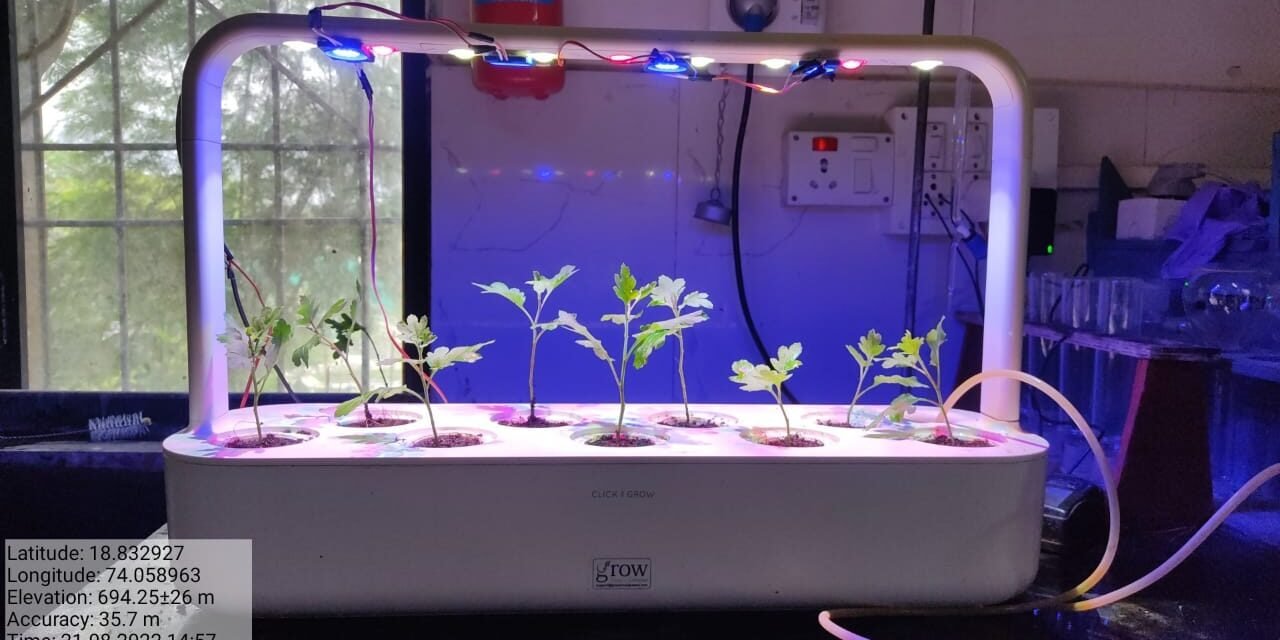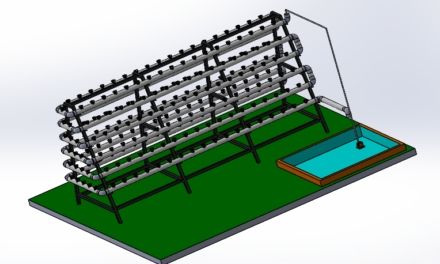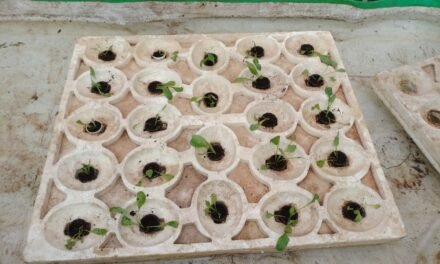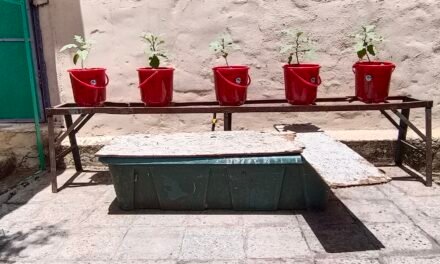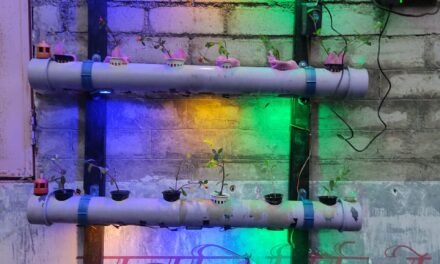3/08/2022
Objectives:
1. Standard Operating Procedure
2. DWC to flood and drain conversion
4/08/2022-5/08/2022
I found one setup with some led light in it, before me some interns have tried to grow plants in it but due to following reasons it was not working properly
1. Lack of light intensity.
2. There was no proper nutrients dosing for plants.
Sakshi Khatane had started this project before me but at that time there was no accurate dosing for the chrysanthemum ,so Dixit sir given this project to me for further experiment . https://vadic.vigyanashram.blog/2022/01/12/interior-led-hydroponics-flood-and-drain/. I am taking up this project so that in future we can plant small plants at our home or we
Introduction:
Light Emitting Diodes represents technology for indoor growing that has technical advantage over traditional lighting sources. It produces less wastage light and than other lighting technologies. There are many types of LED grow lights on market and each light has several advantages and disadvantages. If there is not right color of light, the plants will not grow well.
There are two main colors which are necessary for the hydroponics are blue and red. Blue light is responsible for the growth compact and shapely. Red light is responsible for the plant reproduction in plants in the form of flowering and fruits.
Light also emits heat, . Overheating can damage the plant and affect growth. The temperature of the indoor must be 65-80% and 50-75% humidity. Duration is also important while choosing the right light for hydroponics. Before applying any light source on a plant we need to go consider the plant requirement.
6/08/2022-9/08/2022
MATERIALS REQUIRED FOR LED HYDROPONICS:
| MATERIAL | COST | Avalilability |
| Air stone | 50 | yes |
| Arduino UNO Board | 600 | yes |
| Relay | 90 | yes |
| Adapter (9 v, 2 A) | 110 | yes |
| Adapter (12 v, 2A) | 140 | no |
| Jumper wires | 20 | yes |
| LED | 78 | no |
| Motor | 200 | yes |
| Netpots | 54 | yes |
| Total | 1342 |
10/08/2022-16/08/2022
when I told about my project to sonal mam she told me to collect information related to LED light ,its intensity, which LED is best now in market.
- LED light
2. Its intensity
3. which LED is best now in market.
The data which I searched related to project is as follow:
LED= Light Emitting Diode
Hydroponics= Science of growing crops without soil as base
Data analysis conclude that LED light produce necessary wavelength of wavelength in plant growth. Light intensity influences manufacture of plant food, stem length, leaf color, flowering. Most plant need light waves of red and blue.
Plant needs blue light of wavelength = 400-520 nm
Red light of wavelength= 610-720 nm
How does wavelength affect plant growth:
Certain specified red wavelength will increase production of hormone in plants vegetation that prevents breakdown of chlorophyll. with more chlorophyll a plant generates more nutrients and grows taller with more leafy vegetation.
For small coverage VIPARSPECTRA LED is used in large amount ,cost 15317
17/08/2022
Today I bought blue LED and separated this LED according to existing setup. Then joined this LED with wires.
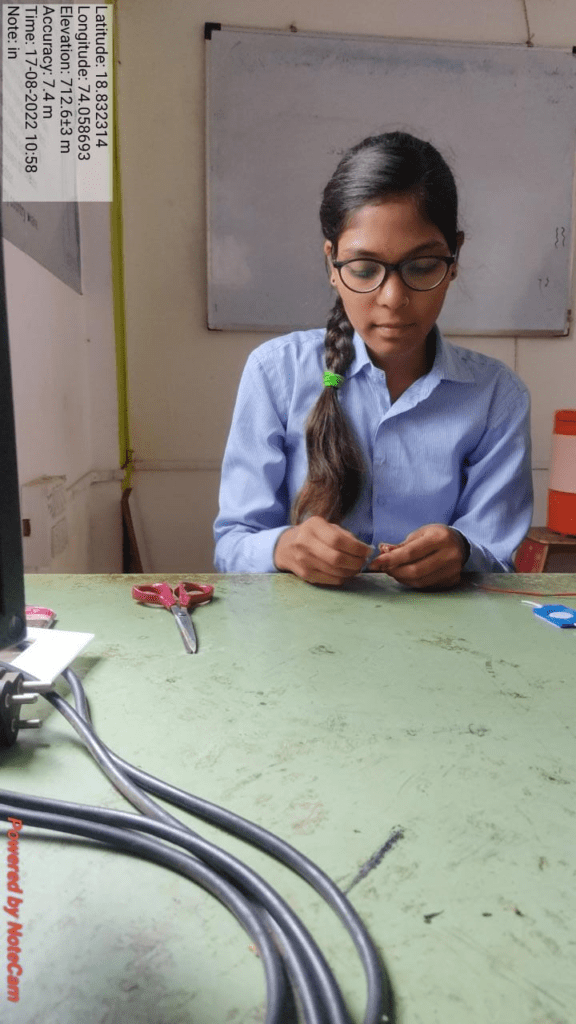
18/08/2022
Today I soldered connected wires and covered this wires with the help of sellotape. Then I sticked this arrangement to builded setup and starts lighting.
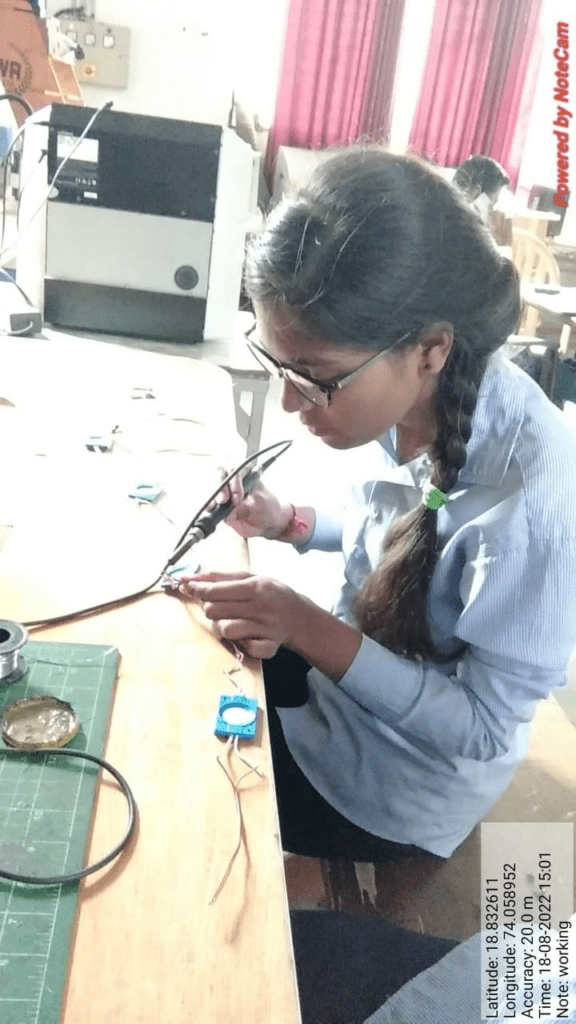
19/08/2022-20/02/2022
Plant need light for photosynthesis, for flowering but some times leaves burn if light intensity is higher. So to measure light following points should be considered.
- Light Intensity
- Light amount ( how many hours)
- Light Intensity: Light intensity is measured in units called Lux. Lux is equal to one lumen per square metere. Lux is generally regarded as standard way to measure light. I have measured intensity of each light by using Luxmeter.
| COLOUR | INTENSITY |
| RED | 5300 Lux |
| WHITE | 2990 Lux |
| BLUE | 6220 Lux |
also measured intensity of light in soil lab, which is around 30 Lux and for polyhouse it varies from 300 to 900 Lux and above i.e It is not uniform.
21/08/2022
On sunday we did plantation of chrysanthemum as follow:
- first I cut small front part of plant with some leaves.
- Then removed unwanted leaves and kept only 3-4 leaves.
- Dipped this plant into aloe vera (Aloe vera should be not spotted, It is used because it is antifungal, antibacterial, and also provide nutrition to plant and acts as root hormone.
- Coco peat is used as medium.
- I have placed all netpots just above level of water. (5 L water).
- At last, Connected bubbler in system to provide aeration for the system.
Chrysanthemum needs 11 hours of sunlight and 13 hours of darkness. therefore the LED need to be off for 13 hours. LED needs
12 V DC supply and 2A current. So I on LED at 7.00 am in morning and off at 6.00 pm
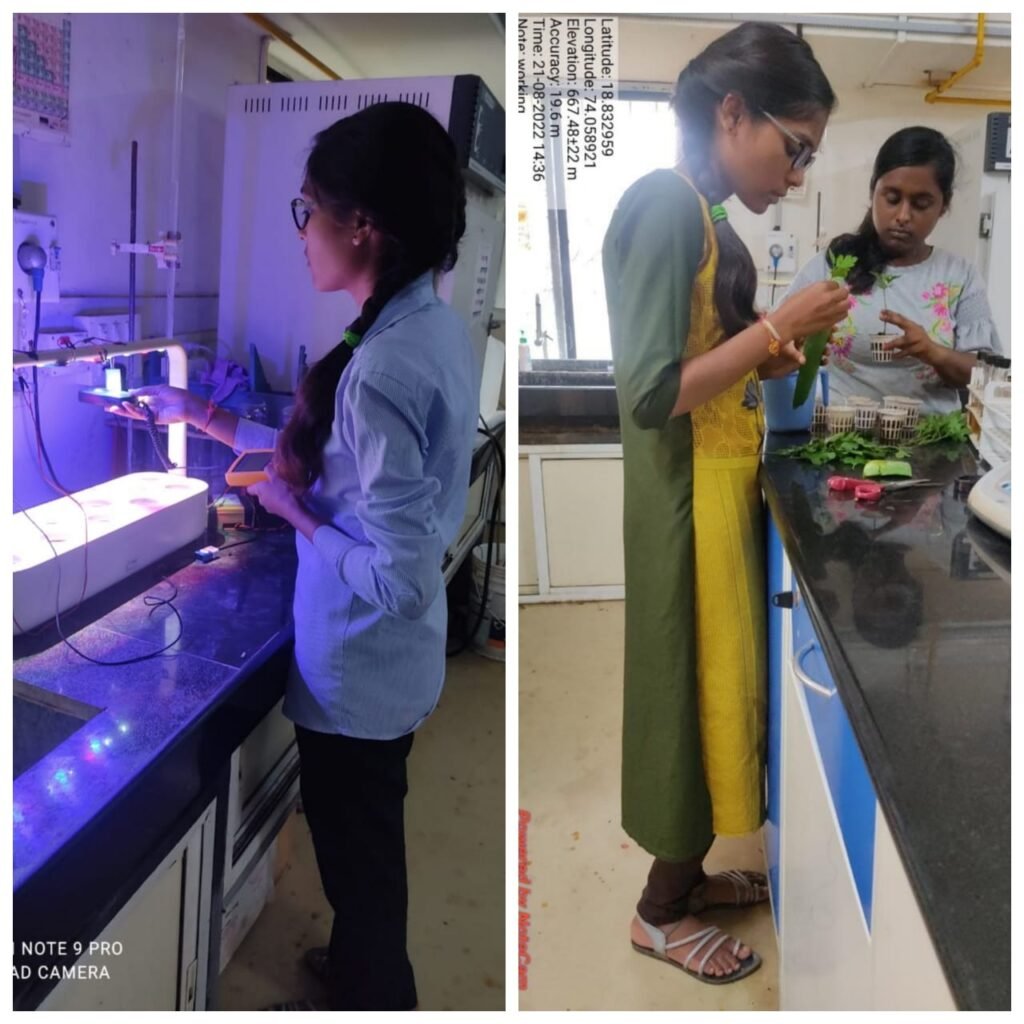
Scientific name: Chrysanthemum
Kingdom: Plantae
22/08/2022
Today I have shifted this LED setup in polyhouse because chrysanthemum requires high amount of heat for its growth .
23/08/2022-25/08/2001
while discussing about project, Prasad sir told that Cocopeat has chances of getting fungus very early. So I searched about the media which will suitable for this project. Finally I found that gravel is media which has low water holding capacity and which will exactly suitable for chrysanthemum. When I discussed this with sonal mam she told me to replace cocopeat with gravel. Then I kept this gravels in trichoderma powder for some minutes and replaced coco-peat with gravels. I used trichoderma because it acts as fungicide.
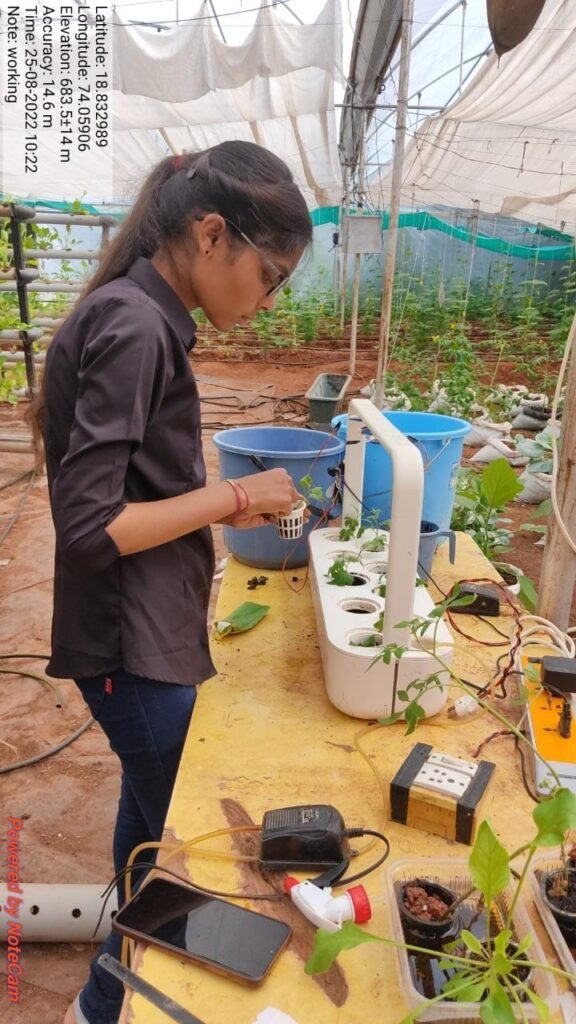
26/08/2022
WHY FLOOD AND DRAIN
One of the main reason I choose to go with flood & drain is its control, low maintenance. Flood and drain system involve periodic Flooding and draining of nutrient solutions. There are two phases of its operation the flood when water and nutrients flow growing areas. The drain is when water back to reservoir. These two actions take turn continuously and hence the name. The system ensures that plants obtain just enough nutrients. Therefore, plants get to grow maturity and healthy and nutritious. It is easy to build structure. It is easy to use. once set up the system the hard part of job is over. the rest of work is straightforward, as it requires minimum supervision and maintenance. The simple tasks are ensuring availability of nutrient solution and constant checking to confirm functionality.shevanti plant needs to be watered frequently as they loose moisture but it also has soil requirement which has good texture and well-draining in nature. this condition is well provided by flood and drain system, by using this system the roots of plants wont be continuously exposed to water.
Coding
int motor = 7;
void setup() {
Serial.begin(9600);
pinMode(motor, OUTPUT); // Set pin 7 to output
}
void loop() {
digitalWrite(motor, LOW); // Set pin 7 as “high” or turn it on
Serial.println(“Relay on”); // prints that the pump should be on
delay(60000); // 1 Minitue delay
digitalWrite(motor, HIGH); // Set pin 7 as “low” or turn it off
Serial.println(“Relay off”); // prints that the pump should be off
delay(1800000); // another 30 minitue delay
}
I have uploaded this coding for Arduino system
Because of this coding motor remains starts for 1 minute and then gets off for 30 minutes.
For this process siphon mechanism has been used, syphon is a long bent pipe that is used to transfer liquid from a reservoir at a higher elevation to another reservoir at a lower level when the two reservoirs are separated by a hill or high-level ground.
Water Circulation Diagram:

29/08/2022
Today I circulated water in system and found that it takes 58 seconds to complete drainage of water.


| EC | 664us/cm |
| TDS | 332ppm |
| Ph | 8.79 |
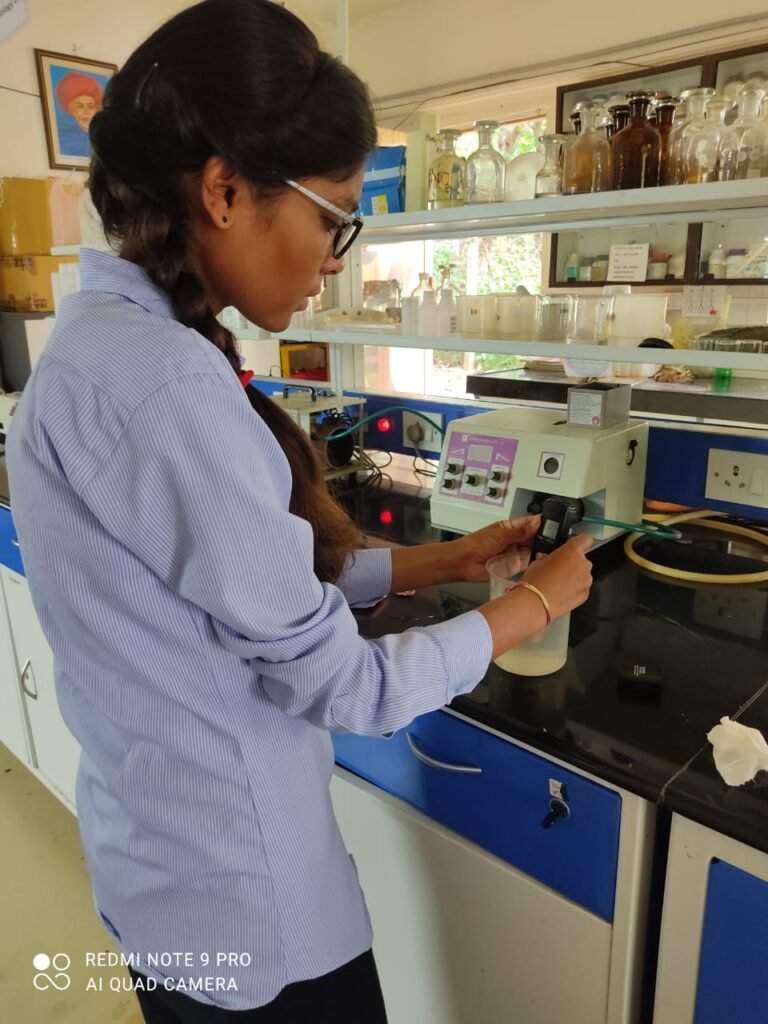
After measuring this values I have discussed with sonal mam about dosing of plants.
31/08/2022
In morning we circulated water in system and then calculated total amount of water in system then adjusted volume of water up to 5 Litre and then checked ph, TDS, EC of water. Which is as follows;
| TDS | 344 ppm |
| ph | 8.74 |
| EC | 875 us/cm |
After discussing with sonal mam I give basic nutrients to chryasanthemum
| Water quantity(Litre) | Fertilizer Quantity | Fertilizer Name |
| 1000 | 115.38 | Potassium phosphate |
| 5 | 0.5769 | |
| 1000 | 311.09 | Calcium nitrate |
| 5 | 1.555 | |
| 1000 | 380 | Potassium nitrate |
| 5 | 1.9 | |
| 1000 | 119.28 | Magnesium sulphate |
| 5 | 0.5964 |

After some time I again checked ph, EC, TDS of water then I found that Ph of water is around 8, but for this system I have to maintain ph in between 6-6.2 (Because plant can absorb nutrients only when we adjust suitable ph for it, otherwise there can be loss of nutrients. )
To lowering ph of water we can add phosphoric acid and to increase add ammonia in water. So I added some drops of phosphoric acid in water then then I found ph near to 6.2 and then I mixed this water in whole system.
After some time I again checked Ph but it was now become 7.2 then I started to add phosphoric acid.
Readings;
| Drops in number | ph |
| 1 | 7.9 |
| 2 | 7.2 |
| 3 | 6.8 |
| 4 | 6.54 |
| 5 | 6.41 |
| 6 | 6.2 |
After 6 drops(for 500 ml) I get desired result. System contains 5 litre of water so I added total 60 drops.
2/09/2022
Today in morning firstly i removed leaves which had aphids on surface
What is aphid
Aphids are insects with soft bodies that cover the leaves and stems of your plants and suck the sap out of your plant. They range from shades of green to grey or reddish brown color. Luckily, these are easy to spot and easy to get rid off.
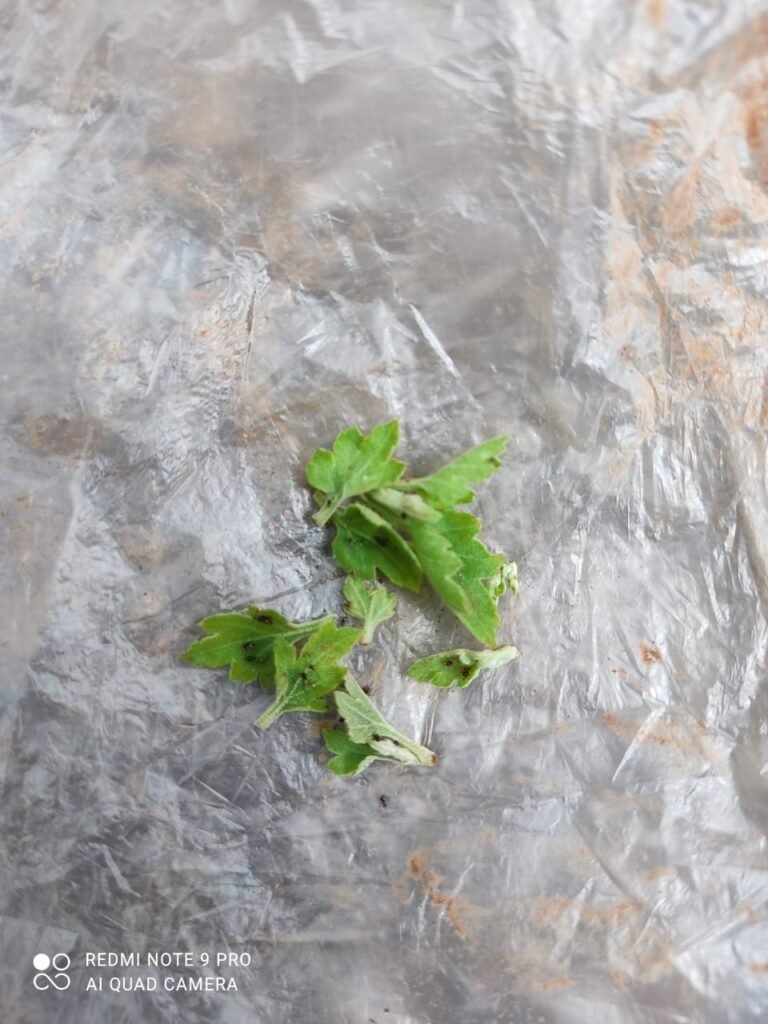
Then I measured Ph of water which is around 6.5 then I decided to mix phosphoric acid in water to lower ph up to 6.2 but while circulating water when I stopped flow of water, water is drained out in bucket ,which is placed near to project but by mistake pipe is dropped down and there was wastage of water and also of nutrients….. so again I filled setup with 7 liter of water, gave same nutrients to plant which I had given yesterday.
I uploaded coding given above(edited) and checked the system is working or not Suvarna mam helped me to uploading coding.
3/09/2022
Todays values:
| TDS | 794 ppm |
| ph | 8.26 |
| EC | 1464 us/cm |
Adjusted ph value by adding phosphoric acid in it.
5/08/2022
I found magnesium deficiency on leaves. Discussing with sonal mam I decided to spray Epsom salt on leaves.
Symptom: Yellowing of leaves.
Quantity: 20 gm of salt for 1 Liter of water
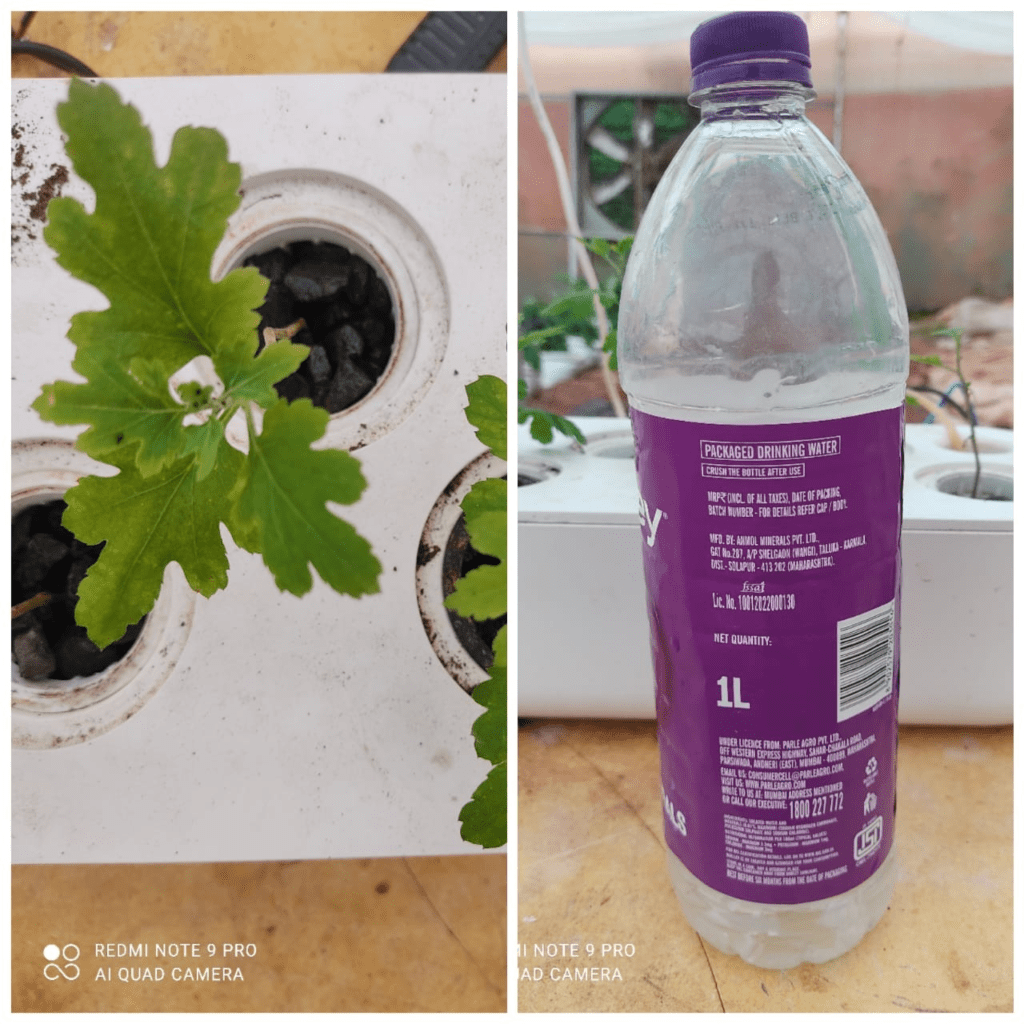
6/09/2022
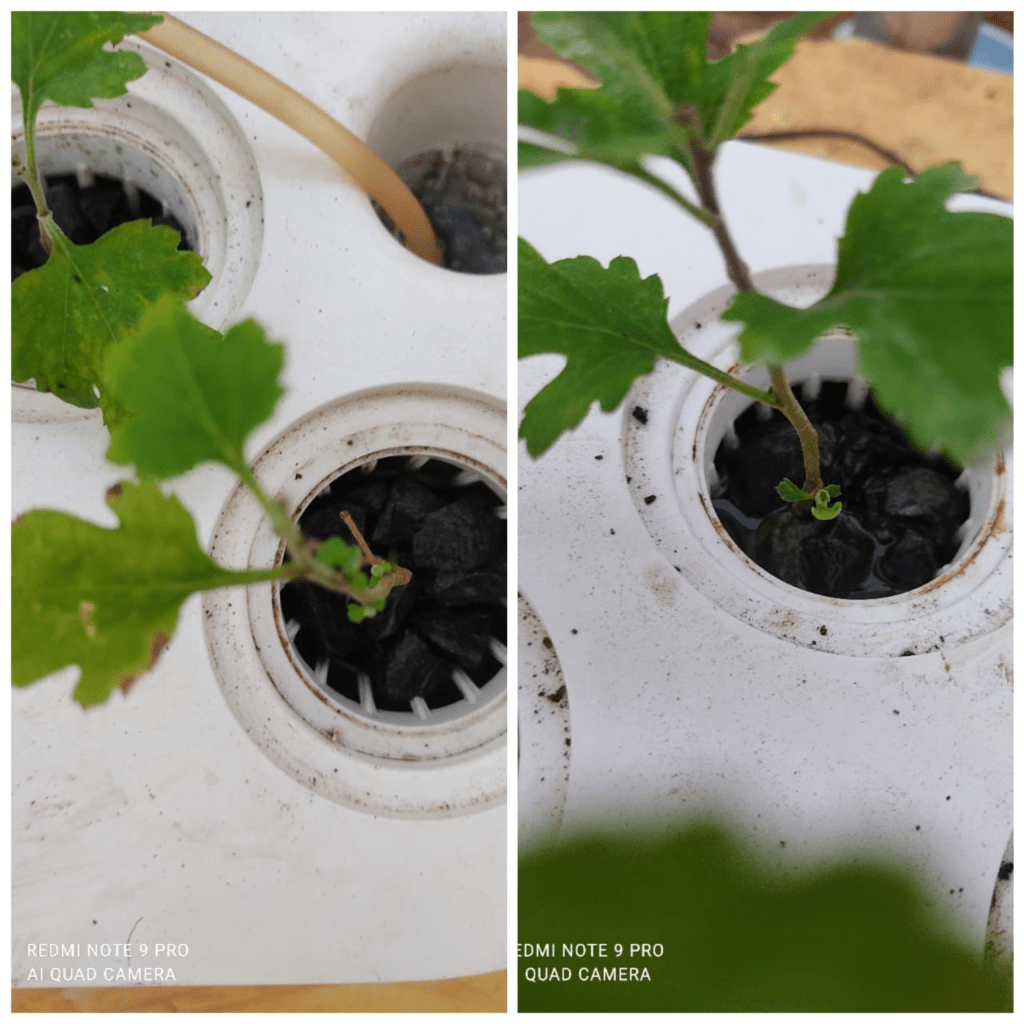
Today I observed that new small leaves are coming
Today I discussed with Suvarna mam in case of problem facing in flood and drain.
Problem: Due to pressure produced by pump water cant retain for long time in system, and this will be harmful for plant growth .
So we decided to do changes in existing flood and drain.
Solution :
We can use two motors for whole system. One motor will help to supply of water in system and second will drain water out of system.
8/09/2022
Today in morning We sprayed pesticide on plants to decrease growth of aphids. Then sprayed humic acid in evening.
Why Humic Acid …..
Humic Acid :Humic acids from highly oxidized lignite, due to the chelation/complexation process, can enhance the availability of nutrients to plants in the nutrient solution. When nutrients are readily available to plants, photosynthesis is increased.
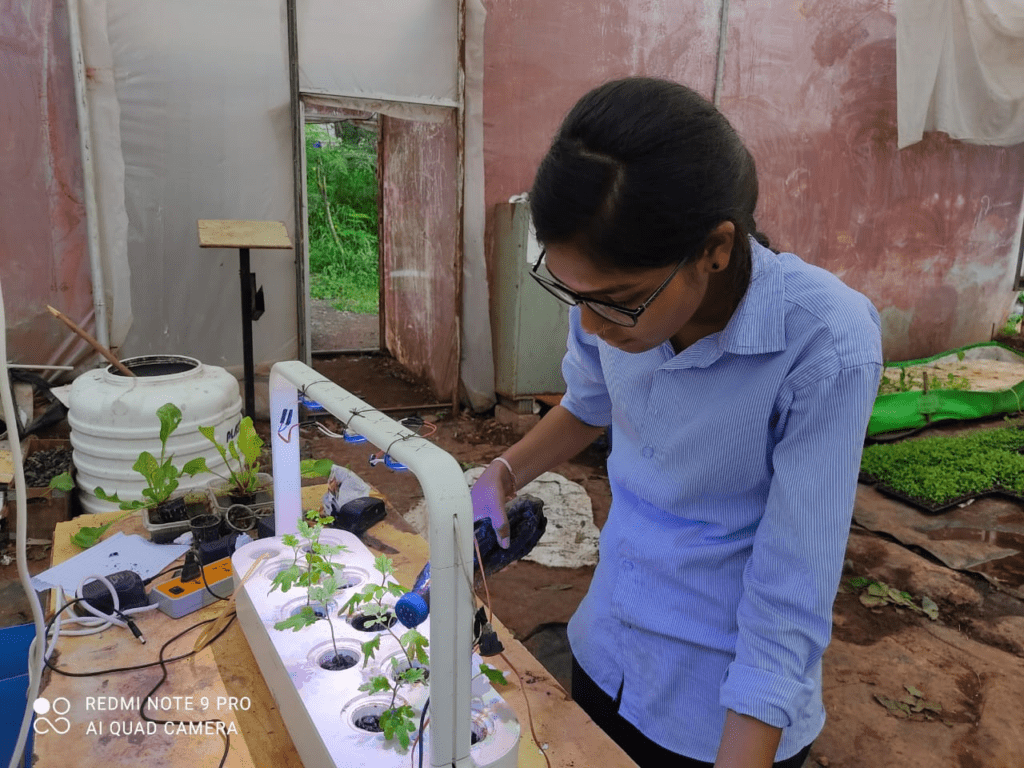
9/09/2022-14/09/2022
Today I found my system is not working. So, I checked the all the wire connection and done soldering again under guidance of Suvarna mam.
15/09/2022
Today I have set coding for Arduino with 15 minutes of interval , Cleaned entire setup of hydroponics. Filled bucket with 10 L of water. Then weighed nutrients for 10 Liter of water.
| Nutrients | Weight (gms) |
| Potassium Phosphate KH2PO4 | 1.1538 |
| Calcium Nitrate Ca(no3)2 | 3.1109 |
| Potassium Nitrate KNO3 | 3.8 |
| Magnesium Sulphate Mgso4 | 1.1928 |
Coding:
int motor1 = 7;
void setup() {
Serial.begin(9600);
pinMode(motor1, OUTPUT); // Set pin 7 to output
}
void loop() {
digitalWrite(motor1, LOW); // Set pin 7 as “low” or turn it on
Serial.println(“Relay on”); // prints that the pump should be on
delay(90000); // 1.5 Minute delay
digitalWrite(motor1, HIGH); // Set pin 7 as “high” or turn it off
Serial.println(“Relay off”); // prints that the pump should be off
delay(900000); //15 Minute delay
}

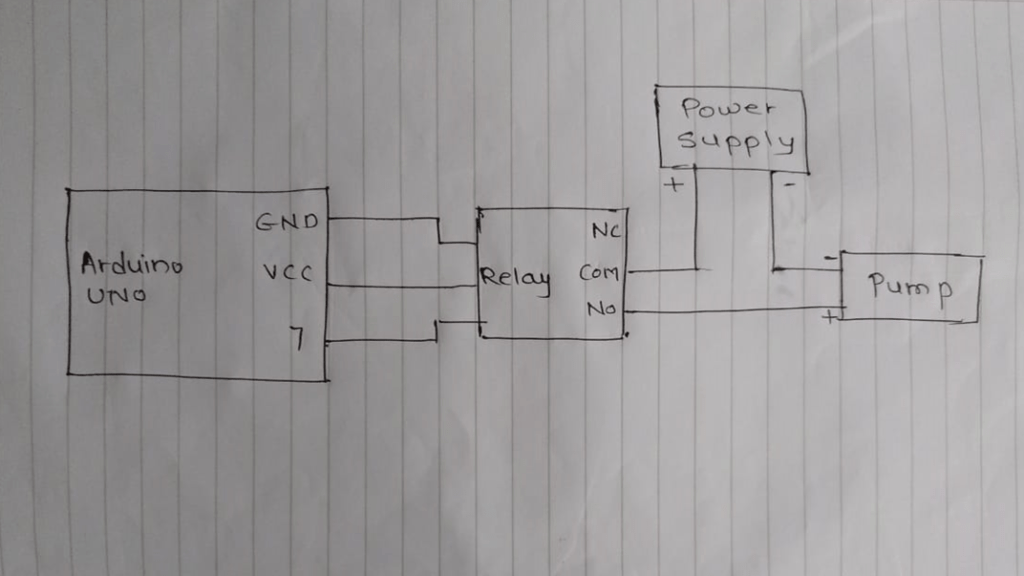
16/09/2022
Measured ph, EC, TDS of water and then maintained ph of water.
| ph | 8.32 |
| EC | 1616 us/cm |
| TDS | 808 ppm |
Decreased ph of water by adding phosphoric acid. By calculation I have added 18 drops.( for 1 litre of water requires 2 drops to reduce ph upto 6.2)
17/09/2022
Readings in morning
| ph | 7.8 |
| EC | 1539 us/cm |
| TDS | 768 ppm |
Maintained ph, EC, TDS by adding 18 drops of phosphoric acid.( for 1 litre of water requires 2 drops to reduce ph upto 6.2)
| ph | 6.2 |
| EC | 1545 us/cm |
| TDS | 772 ppm |
19/09/2022
Height of chrysanthemum in hydroponics
Readings:
8.9+10.3+10.5=29.7
Avg height= 29.7/3=9.9 cm (Plants are of unequal growth so I took average height of plants)
Intensity of light 7800 lux near to plant
20/09/2022
Today I observed Septoria leaf spot on some leaves.
Treatment : Mixed 25 gm of Trichoderma powder in 5 ml of copper containing liquid. ( Because I wanted to spray liquid which contain cu)
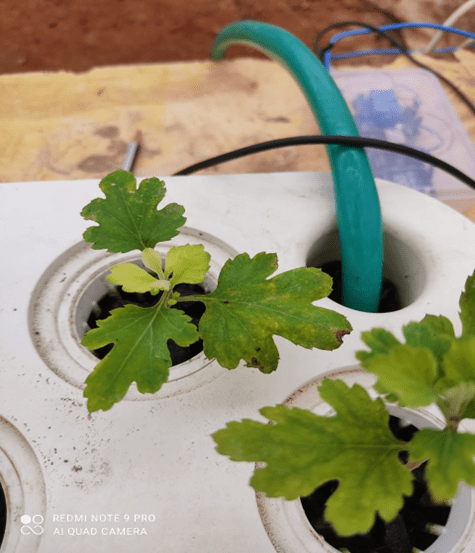
Humidity and temperature values:
| Date | Humidity | Temperature |
| 20/09/2022 | 72.8% | 24.9°C |
| 23/09/2022 | 64.4% | 26.3°C |
Today I have placed two plants in sunlight to compare led grown plants and naturally grown plants .
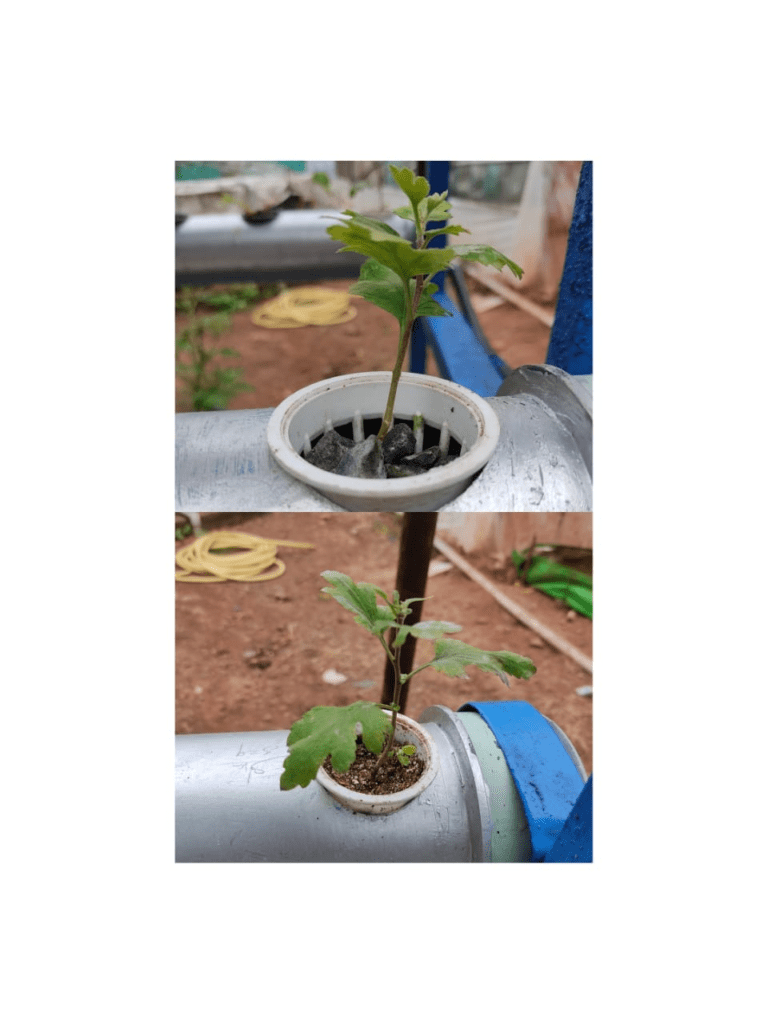
Today I observed root growth of plant.
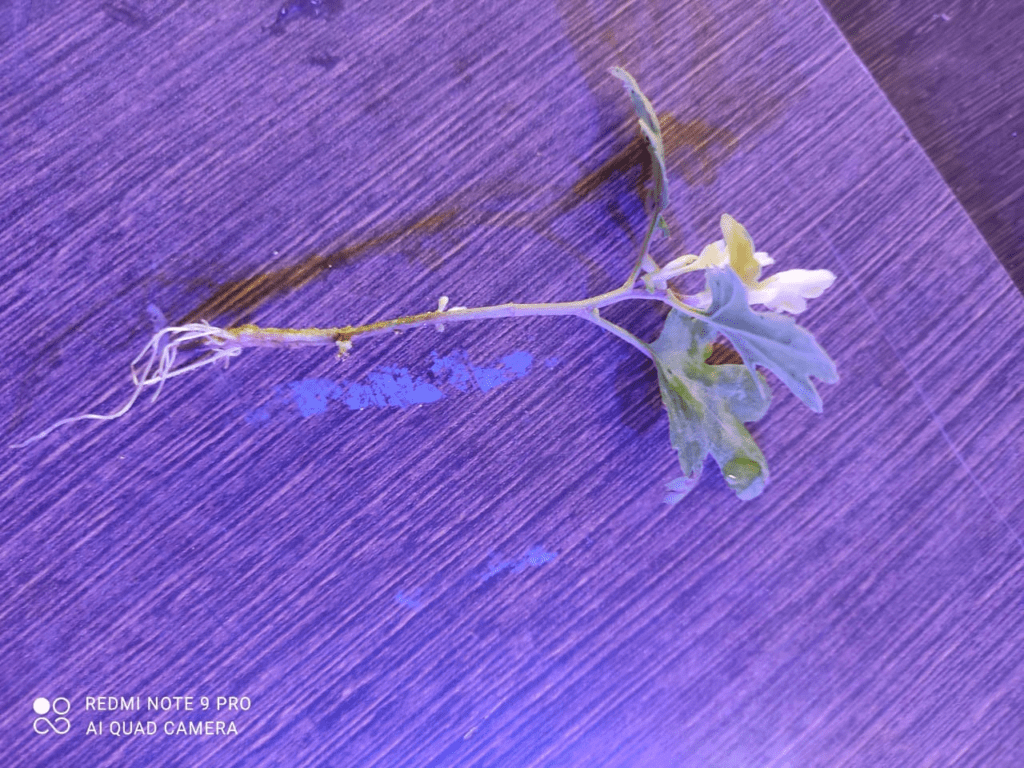
23/09/2022
Sunlight intensity 10000-12000 Lux
RH – 65%
TEMP – 27.4 °C
24/09/2022
Today I had discussion with dixit sir, sir told me to take some coriander plants for further study. Following are some basic points which we should consider for indoor hydroponics.
Germination of coriander :
Germination under 150 umol/m^2/s
Temp : 25°C for day and 21°C for night
Light ours: 16 h
Sunlight: 6 hours
Ph – 5.8-6.4
TDS – 800-1000
Suggested medias for hydroponics:
1.Nylon net scrap
2. Vermiculite
3. Coco coir
4. gravel
25/09/2022
Cleaned hydroponic setup .
26/09/2022
Sowing of coriander seeds in hydroponics.
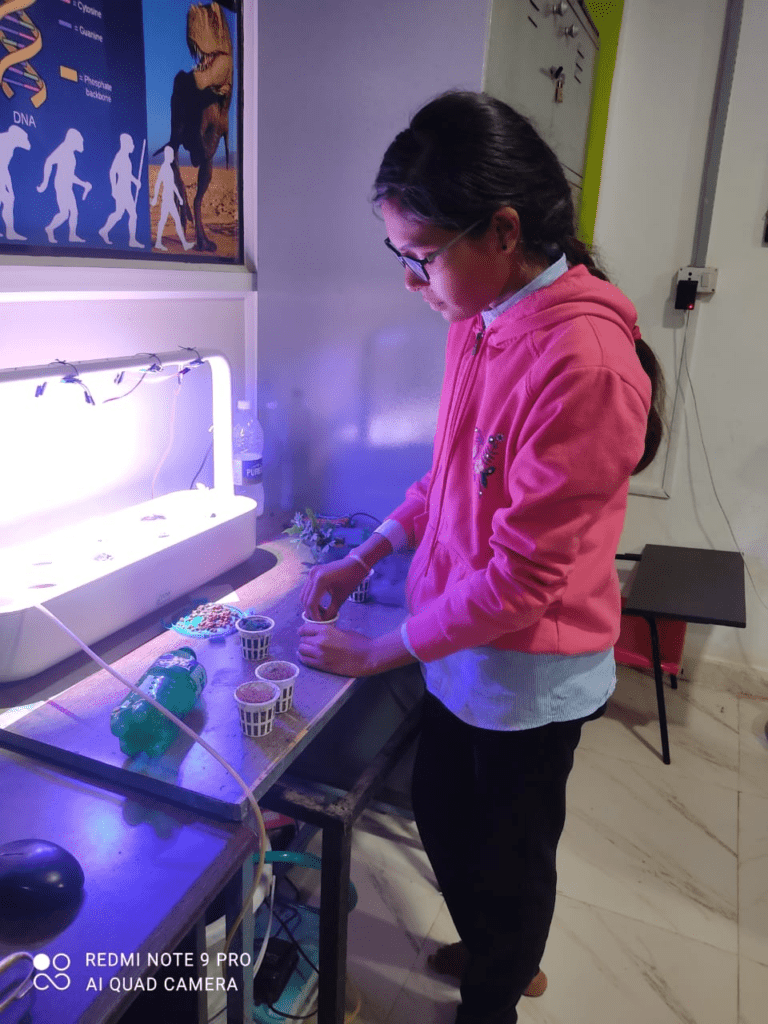
28/09/2022
Today I have discussed with dixit sir about nutrients , Then sir suggested me , sprouting of coriander seeds in cotton. Soaked some coriander seeds in mgso4 for 3 hours and then tied this seeds in cotton.
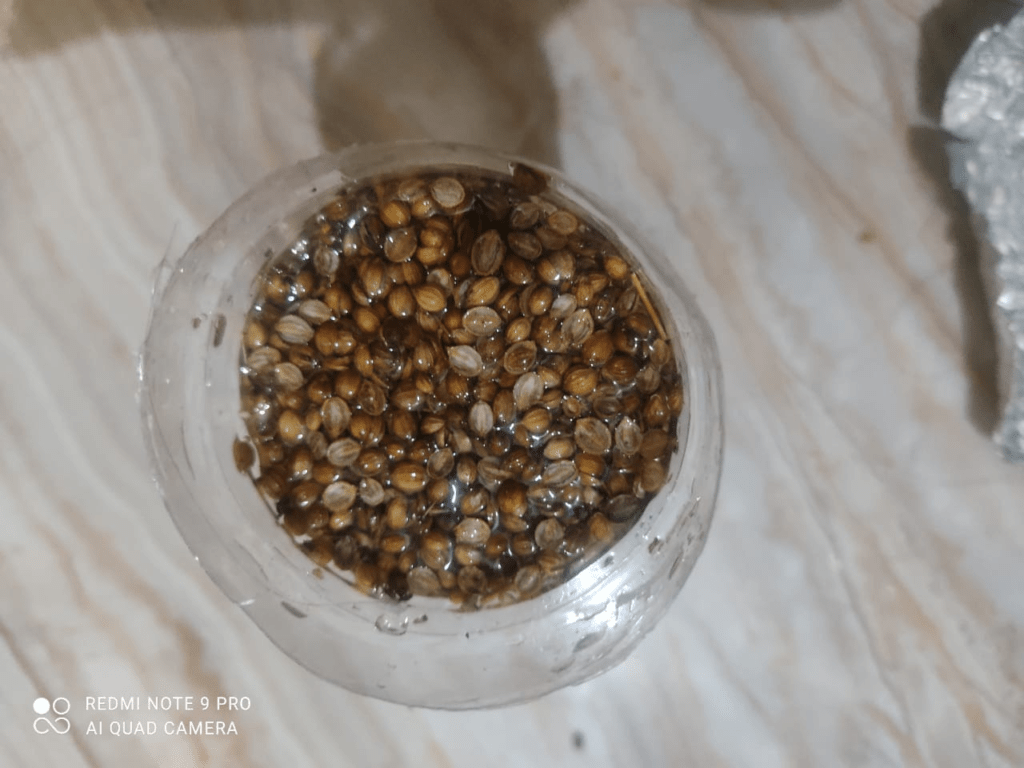
3/10/2022
Today I found , due to insufficient soaking of seeds there was no sprouting of seeds. Then based on this result I again decided to repeat this experiment again.
6/09/2022
Day 10

Today I found max growth of plant in vermiculite
7/10/2022
I had prepared nutrient solution for coriander as below:
- Took 12 liters of water
- Then measured ph, EC, TDS of water TDS was 344 PPM (Plant requires 400 ppm TDS)
- So I tried to maintain this TDS by adding some micronutrients in it.
- Used scale to mixing nutrients properly in water.
8/10/2022

10/10/2022
Today I measured water in reservoir, I found that 11.5 liters of water was present in reservoir i.e. 500 ml water was used by plants To maintain the proper supply of water I added 500 ml of water in it.
12/10/2022
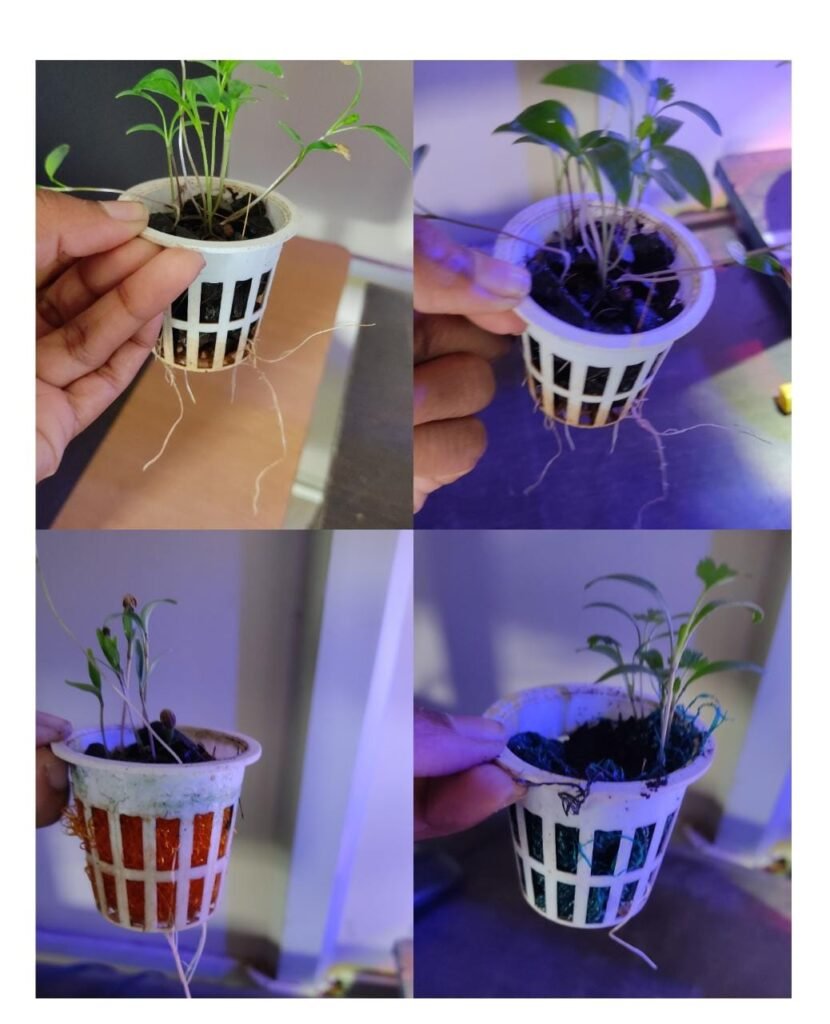
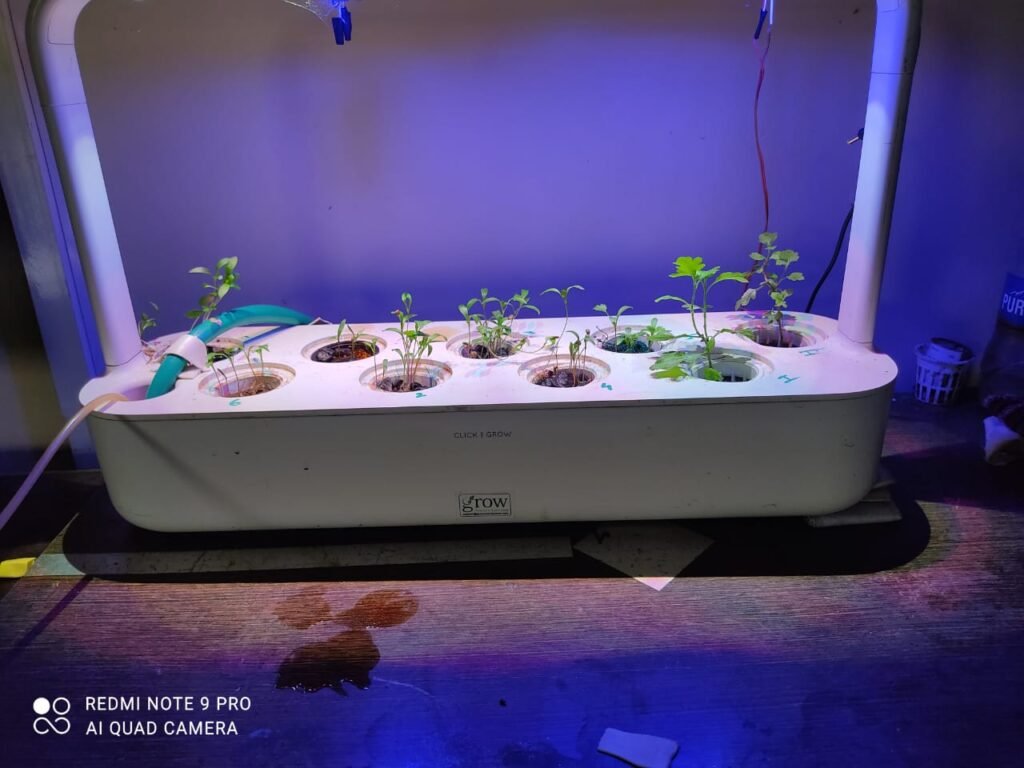
18/10/2022
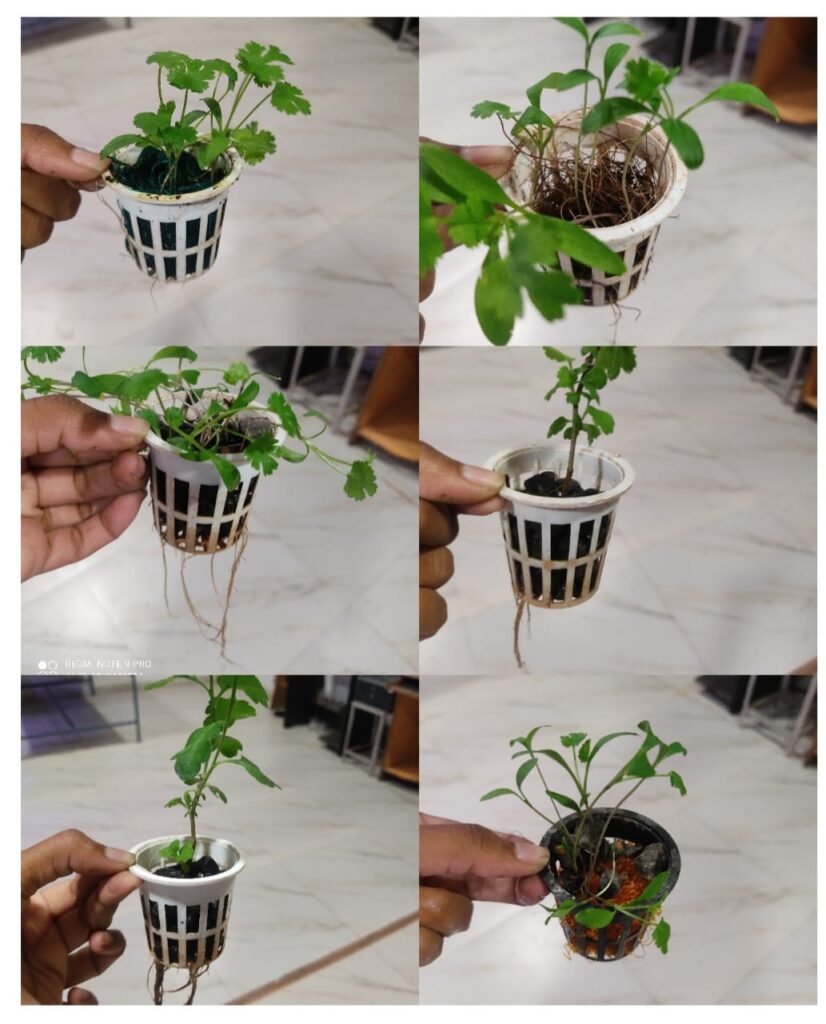
Today I prepared second nutrient solution for cilantro, amount of each nutrient in solution is as follows
| Nutrients | Adjusted TDS (ppm) |
| NPK 19-19-19 | was added till TDS raised from 210 to 305 PPM |
| Calcium Nitrate | Was added till TDS raised 305 from 360 |
| Magnesium sulphate | Was added till TDS raised to 360 from 380 ppm |
| Micronutrients | Were added to raise TDS to 380 from 396 |
Initial TDS is 210 ppm
Readings:
TDS=396 ppm
Ph=7
EC=793 us/cm
After adding phosphoric acid
TDS=394 ppm
Ph=6.3
EC=790 us/cm
29/10/2022
Today I measured intensity of light by using luxmeter.
at 26cm intensity is 5600 lux & at 13 cm it is 11000 lux.
Observations
31/10/2022
Today I prepared nutrient solution for plants under sunlight.
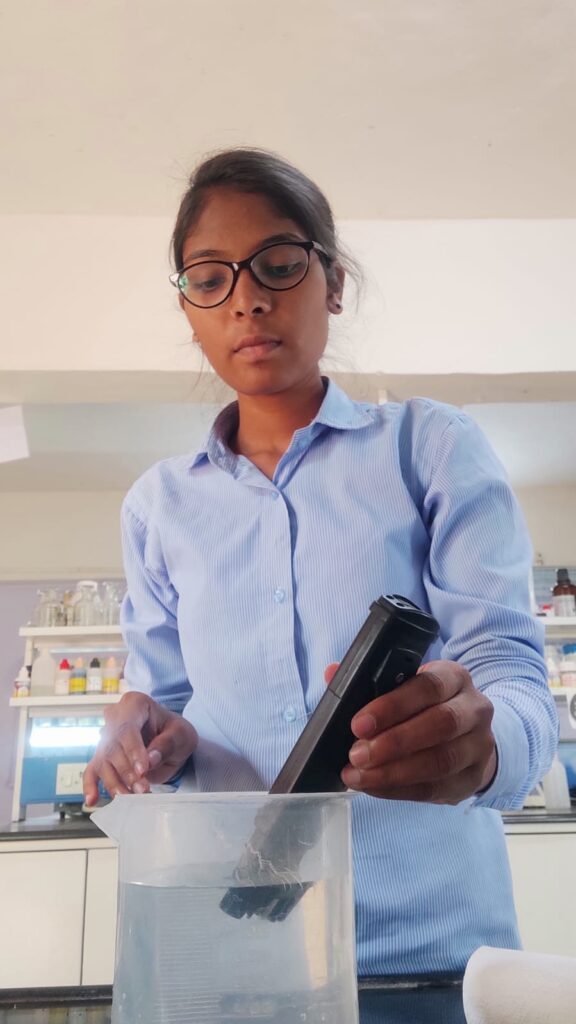
1/11/2022
In flood and drain system there is water loss, so we have to maintain that level of water.
Observation: Height of water after 7-8 days from 25 cm to 19 cm
Then added 1 liter of water.
3/11/2022
| Water parameters | Readings |
| TDS | 412 ppm |
| pH | 5.7 |
| EC | 822 µS |
4/11/2022
Readings of RO water, which I have mixed.
| Water parameters | Readings |
| TDS | 270 ppm |
| pH | 6.8 |
| EC | 53 µS |
5/11/2022
Observations:
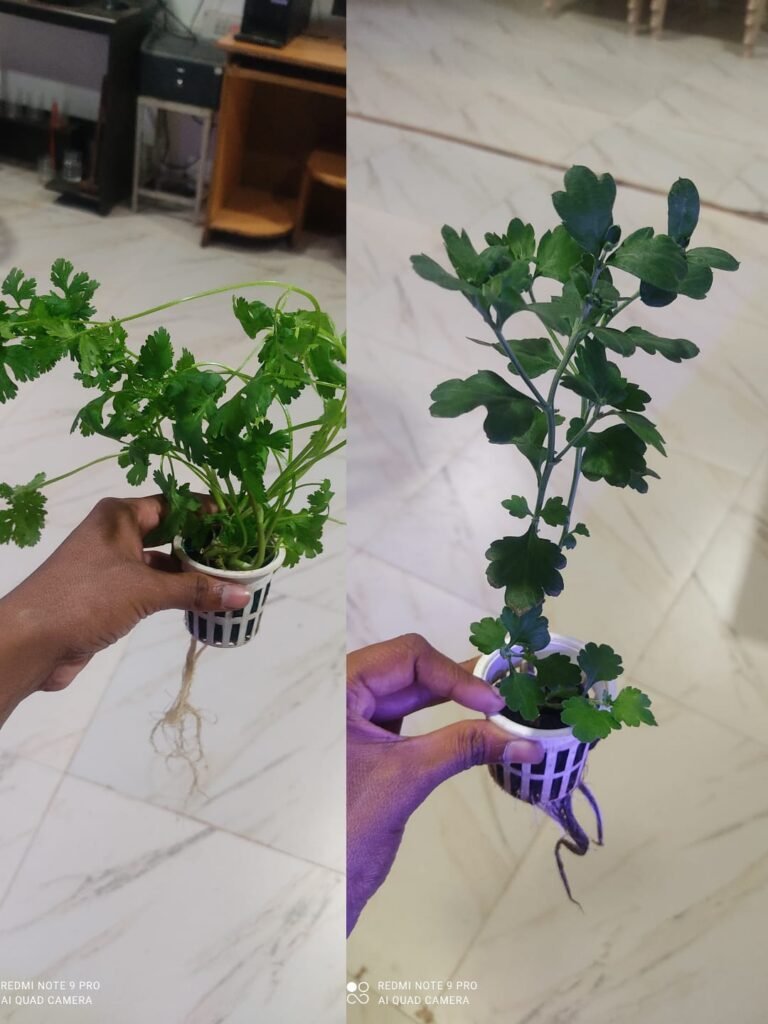
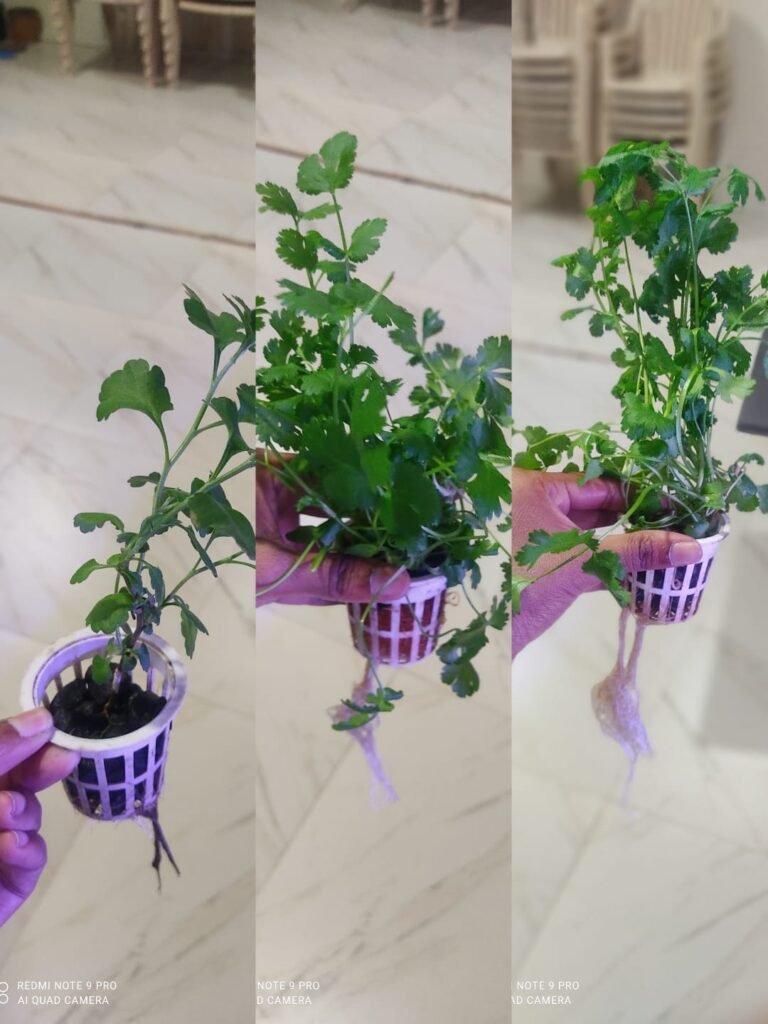
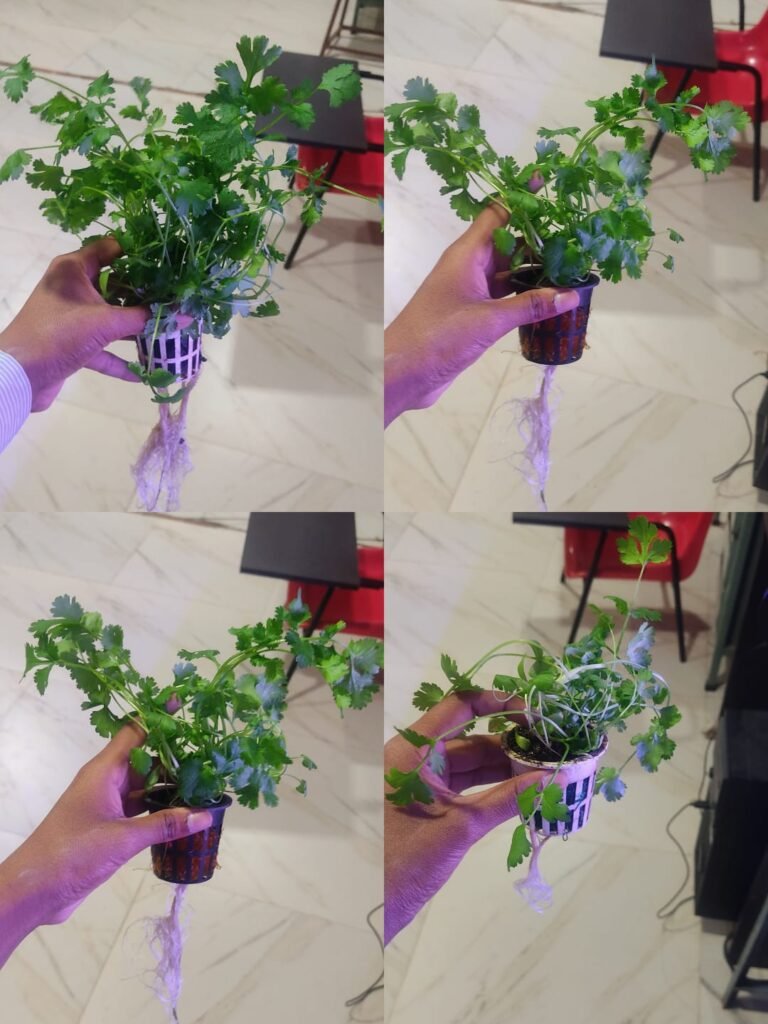
8/11/2022
Harvested cilantro after 42 days.

11/11/2022
I kept some plant in setup for further observation . Prepared nutrient solution for those plant.



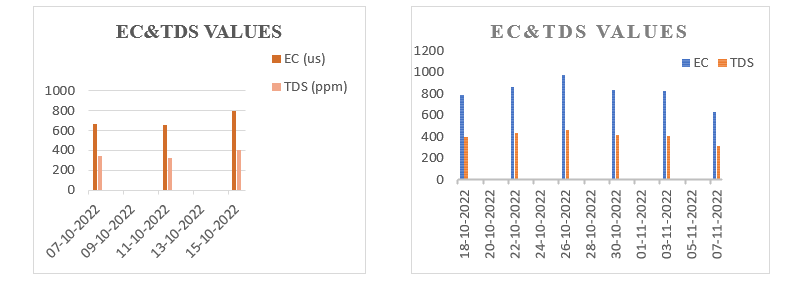
Result:
- The results showed a significant effect of the newly added light colour.
- Overall plant was looking good in gravel containing media.( Considered root growth ,support of media to plant & height of cilantro)
- Nylon and cocopeat were also showed great result.
- In initial days nylon, gravel, coco coir required more water than coco peat and vermiculite. because vermiculite and cocopeat has high water holding capacity.
- In indoor hydroponics germination of coriander in vermiculite as media, occurs very early as compared to others growing medias.
- Selected dosing criteria supports to growth of cilantro.
Conclusion:
- Coriander supports to flood and drain system.
- Plant can grow tremendously when light intensity is suitable, lack of light will affect to plant growth.
- Plant require different amount of light while growing.
- in hydroponics selection of media which will support to plant until harvesting is necessary.
- Simple blue LED cob also helps in growth of plants.
14/11/2022
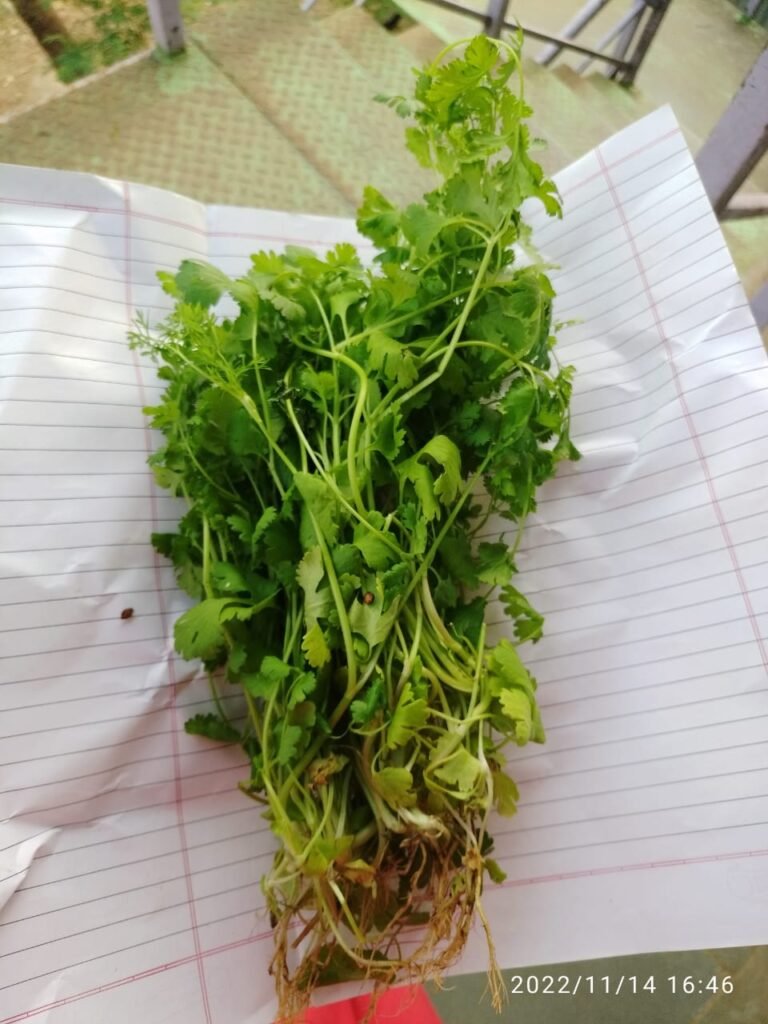
By studying the things obtained in this experiement we can think about whether larger system can be made and it will certainly help our soil conservation to a large extent.
Path Forward:
The better plant growth was combination of nutrient change and change in intensity and frequency of light.
Need to carry experiment to study of each factor.
Following are some basic things which I learned while this experiement:
Light intensity influences the manufacture of plant food, stem length ,leaf colour and flowering. Generally speaking, plant grown in low light tend to be spindly with low light green leaves. A similar plant grown in very bright light tends to be shorte, better branches,and have larger,dark green leaves.

